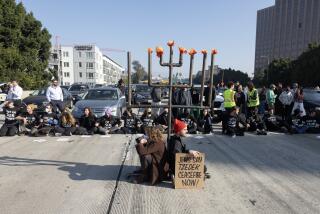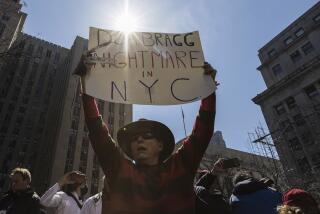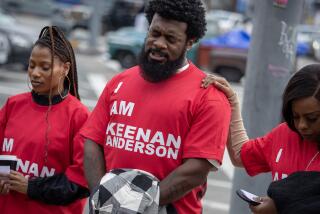From one street in Sanford, Fla., to the streets of N.Y. and L.A.
In a way, part of the outrage had always been about public space: Trayvon Martin, 17, carrying a can of iced tea and a bag of Skittles, was walking home when he was shot dead after a struggle with a neighborhood watch volunteer who had viewed him as suspicious.
The death shattered those in Sanford, Fla., who knew Martin, but eventually touched strangers who saw a question they would later pose about their sons all over the country: Could a black boy walk home in public without being suspected of a crime?
On Sunday, a day after George Zimmerman was found not guilty of murdering Martin -- in a case that rose to such national import that President Obama was compelled to remark on the shooting -- demonstrators took over public spaces across the country to protest the death of a boy they’d never met.
But Martin’s name was certainly on their lips, and in contrast with the obscurity from which his death first arose, they brought their cause to some of the most iconic locales in Los Angeles and New York.
A Sunday demonstration in Union Square in Lower Manhattan eventually mobilized into a march that pushed past police resistance to reach Times Square about two miles away, where tourists gaped at the placard-wielding, chanting demonstrators. (The number was rumored to be more than 1,000; police wouldn’t confirm crowd totals.)
Some of the chants sounded like echoes of the Occupy Wall Street movement that emerged in Zuccotti Park: “What do we want?” “Justice!” “When do we want it?” “Now!”
Except that when the demonstrators formed a human microphone to shout a speaker’s words throughout the square, they spoke Martin’s name instead of shouting down bankers and hedge-funders.
Trayvon Martin rally in Times Square via @NerdyWonka pic.twitter.com/mINMrLbdxI— Jim Roberts (@nycjim) July 15, 2013
The demonstrators’ march turned frantic as they embarked toward Harlem, going against the grain of traffic on Fifth Avenue, which came to a halt.
Trayvon march now routing up Fifth Ave. Southbound traffi stalled. Police interspersed among protesters. pic.twitter.com/wu7W4WR9Gh— Andrew Katz (@katz) July 15, 2013
The night was at times tense, with police shoving reporters and pedestrians, and at times comical, as squadrons of officers in pairs wandered the streets in the muggy heat of a New York summer, admitting they didn’t know where the protesters had gone. (Time magazine’s Andrew Katz saw one NYPD officer jump into an already-taken cab to catch up with the protesters after they took a turn up Park Avenue.)
Police used pepper spray on the protesters at Park Avenue and 71st Street, as uniformed doormen and several residents looked on. One woman sat crying on the sidewalk, comforted by several marchers, while others kept the protest going.
“There was one rowdy guy, and he was getting physical,” said Reuben Hayslett, who was among the marchers. “The cops just sprayed and everyone -- even them -- started coughing.”
Troy Reed was ultimately one of those arrested as NYPD’s crowd control swooped in to whittle down the crowd’s numbers, and he shouted out his motive as he came under arrest.
“That could have been my son! I had to march!” Reed yelled as officers cuffed his hands behind his back and guided him into a van with a handful of other protesters.
Reed’s 15-year-old son, Chase, and his friend Jordan Alfredi stood nearby, watching. “We were just trying to march for Trayvon – no justice, no peace. But the police cars kept pulling up, and they just got aggressive,” Chase Reed said.
“They pulled out their sticks,” Alfredi added.
Sometimes there are limits to protesting in public.
Take Los Angeles, for example, where a Martin protest in South L.A. on Sunday stunned drivers on the eastbound 10 Freeway when demonstrators arrived and suddenly blocked the lanes -- and the traffic -- precipitating a confrontation with police.
People are marching in the name of Trayvon Martin in LA on the 10 freeway. I love it. Wish I could be there. pic.twitter.com/yxR7EbR57L— Kleshaam. (@KAS_VonSham) July 15, 2013
LAPD getting ready to shoot protestors with rubber bullets on freeway. pic.twitter.com/m3m4kcueRO— Jasmyne Cannick (@jasmyne) July 15, 2013
Officials said portions of the 10 were closed from 6:20 p.m. to 6:44 p.m. but were then reopened.
Demonstrators meandered while the LAPD went on citywide tactical alert. The city’s brand-new mayor, Eric Garcetti, weighed in delicately on Twitter as police reported that some demonstrators had thrown batteries and glass bottles.
“Nonviolence is a powerful&just weapon..It is a sword that heals-MLK.” Exercise 1st Amendment and practice peace in City of Angels tonight.— Eric Garcetti (@ericgarcetti) July 15, 2013
Is it possible to block traffic peacefully? Does unruliness necessarily equal violence? Police didn’t stop the demonstrators as they made their way up to Hollywood, where some marchers encouraged tourists to photograph them and join them in the demonstration.
Meanwhile, street vendors went about their business, grilling hot dogs and hawking tickets for comedy shows as police helicopters hovered overhead.
From Crenshaw & MLK to Hollywood & Highland, been going about 6 hours & 45 minutes straight now. #JusticeForTrayvon pic.twitter.com/xolkPXsmOe— Gary Kavanagh (@GaryRidesBikes) July 15, 2013
“That child’s life was lost,” said Jessica Smith, in Leimert Park, who identified herself as a “senior citizen from Los Angeles.” “He could have been my son. We need to seize his tragic demise to incite a movement in the right way. We want all of our children safe.”
The protest eventually dwindled, ending with 80 protesters chanting, “No justice, no peace!” outside the CNN building on Sunset Boulevard in Hollywood.
Then the public assembly was declared unlawful, and the police closed in. More than 100 LAPD officers in riot gear converged on the crowd, arresting protesters and telling people to disperse. Some officers fired nonlethal rounds into the crowd. At least eight people were arrested.
Then quiet returned to the streets.
It was just another day in #LA...good night folks. #ilovela #TrayvonMartin— Jasmyne Cannick (@jasmyne) July 15, 2013
Pearce reported from Los Angeles. Alana Semuels contributed to this report from New York, and Joe Mozingo, Thomas Curwen and Andrew Blankstein contributed from Los Angeles.
ALSO:
Lawyer says Zimmerman wants his gun, needs it ‘even more’
Trayvon Martin demonstration moves into Times Square in New York
Justice Department inquiry into Trayvon Martin slaying remains open
More to Read
Sign up for Essential California
The most important California stories and recommendations in your inbox every morning.
You may occasionally receive promotional content from the Los Angeles Times.











